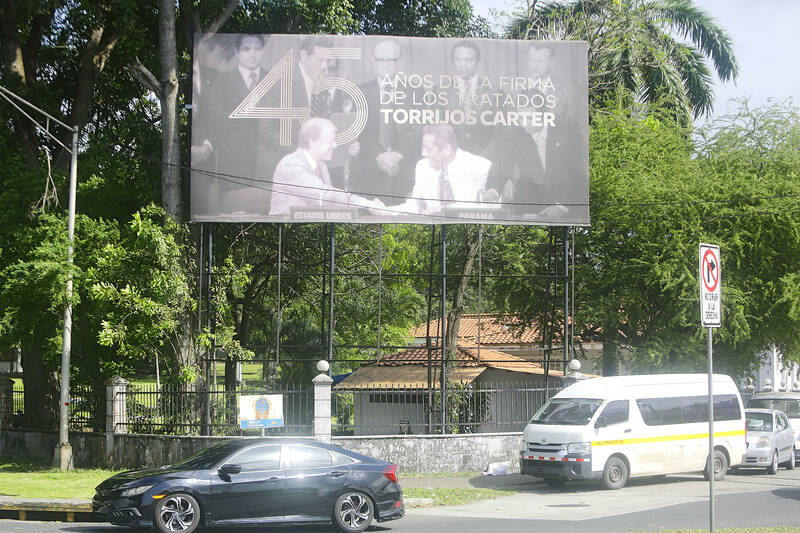US President Donald Trump’s bid to take back control of the Panama Canal has put his counterpart Jose Raul Mulino in a difficult position and revived fears in the Central American country that US military bases will return.
After Trump vowed to reclaim the interoceanic waterway from Chinese influence, US Defense Secretary Pete Hegseth signed an agreement with the Mulino administration last week for the US to deploy troops in areas adjacent to the canal.
For more than two decades, after handing over control of the strategically vital waterway to Panama in 1999 and dismantling the bases that protected it, Washington has regularly conducted maneuvers in the country.

Photo: EPA-EFE
WILL US BASES RETURN?
Although the agreement does not allow the US to build its own permanent bases, Washington will be able to maintain a long-term rotational force in Panama, similar to the one it has in Australia and other countries, for training, exercises and “other activities.”
The US will be able to deploy an unspecified number of personnel to three bases that Washington built when it previously had an enclave in the canal zone.

Photo: AFP
That is a “flagrant violation” of the constitution, which prohibits foreign bases, and the 1977 handover treaties that establish the “neutrality” of the canal and permit only Panama to have military forces on national territory, said Euclides Tapia, a Panamanian professor of international relations.
But there is a loophole: one of the treaties “allows the US to defend the canal when it feels the neutrality is jeopardized,” said Will Freeman, an expert at the Council on Foreign Relations, a US-based think tank.
Benjamin Gedan, former director for South America on the US National Security Council, argues that Panama has cooperated with the US in securing the canal. Panamanian lawyer Arturo Hoyos sees no violation of laws or treaties, as the new agreement allows “joint” operations.
MULINO IN TROUBLE?
Mulino’s government says that the facilities and land belong to Panama and will be for “joint use” by US and Panamanian security forces.
He maintains that he has not ceded an inch of sovereignty to Trump, a natural right-wing ally.
The agreement is a “trade-off” because it “limits the Trump administration’s pressure tactics and hostility and maybe the scope of the concessions” by Panama, Freeman said.
“The risk that nobody’s pricing in, at least on the US side, is that they make Mulino a lame duck” by humiliating him, leaving the Panamanian leader “unable to govern,” he added.
Former presidential candidate Ricardo Lombana accused Mulino of “camouflaging” military bases and disguising “surrender” as “cooperation.”
“The United States is recolonizing and reoccupying us,” said Julio Yao, who advised the Panamanian government in the 1977 negotiations.
Gedan, a professor at Johns Hopkins University, believes Panamanians “are not willing” to allow the return of US bases due to the trauma of the past occupation of the canal zone and the 1989 US invasion to overthrow dictator Manuel Antonio Noriega.
WHAT DOES TRUMP WANT?
The US considers a Hong Kong company’s operation of ports at both ends of the canal to be a threat to its national security.
“Trump wants to minimize the risk of Beijing blocking the canal to prevent the passage of military vessels in a potential conflict,” Gedan said.
Natasha Lindstaedt, an expert at Britain’s University of Essex, sees the US moves as “part of a larger conflict with China as the US is trying to curb China’s influence in Panama and the region more generally.”
Freeman said that the Trump administration “most likely is trying to show that if it wanted to, it could close the canal to Chinese commerce as a way of exerting pressure on China, either not to invade Taiwan or in the event of a conflict over Taiwan.”
“What we’re seeing in Panama is also about Trump’s doctrine of peace through strength,” he said.
But Tapia was skeptical that China really poses a threat, suggesting the threats were aimed at boosting Trump’s domestic support.
“Canada becoming part of the United States or saying that they will take over the canal and Greenland is just a gimmick aimed at the American public,” he said.

The Lee (李) family migrated to Taiwan in trickles many decades ago. Born in Myanmar, they are ethnically Chinese and their first language is Yunnanese, from China’s Yunnan Province. Today, they run a cozy little restaurant in Taipei’s student stomping ground, near National Taiwan University (NTU), serving up a daily pre-selected menu that pays homage to their blended Yunnan-Burmese heritage, where lemongrass and curry leaves sit beside century egg and pickled woodear mushrooms. Wu Yun (巫雲) is more akin to a family home that has set up tables and chairs and welcomed strangers to cozy up and share a meal

Dec. 8 to Dec. 14 Chang-Lee Te-ho (張李德和) had her father’s words etched into stone as her personal motto: “Even as a woman, you should master at least one art.” She went on to excel in seven — classical poetry, lyrical poetry, calligraphy, painting, music, chess and embroidery — and was also a respected educator, charity organizer and provincial assemblywoman. Among her many monikers was “Poetry Mother” (詩媽). While her father Lee Chao-yuan’s (李昭元) phrasing reflected the social norms of the 1890s, it was relatively progressive for the time. He personally taught Chang-Lee the Chinese classics until she entered public

Last week writer Wei Lingling (魏玲靈) unloaded a remarkably conventional pro-China column in the Wall Street Journal (“From Bush’s Rebuke to Trump’s Whisper: Navigating a Geopolitical Flashpoint,” Dec 2, 2025). Wei alleged that in a phone call, US President Donald Trump advised Japanese Prime Minister Sanae Takaichi not to provoke the People’s Republic of China (PRC) over Taiwan. Wei’s claim was categorically denied by Japanese government sources. Trump’s call to Takaichi, Wei said, was just like the moment in 2003 when former US president George Bush stood next to former Chinese premier Wen Jia-bao (溫家寶) and criticized former president Chen

President William Lai (賴清德) has proposed a NT$1.25 trillion (US$40 billion) special eight-year budget that intends to bolster Taiwan’s national defense, with a “T-Dome” plan to create “an unassailable Taiwan, safeguarded by innovation and technology” as its centerpiece. This is an interesting test for the Chinese Nationalist Party (KMT), and how they handle it will likely provide some answers as to where the party currently stands. Naturally, the Lai administration and his Democratic Progressive Party (DPP) are for it, as are the Americans. The Chinese Communist Party (CCP) is not. The interests and agendas of those three are clear, but